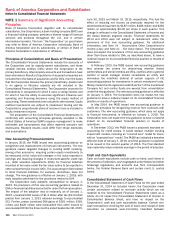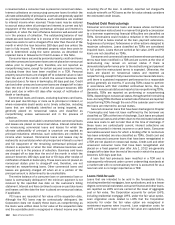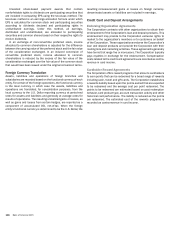Bank of America 2015 Annual Report Download - page 138
Download and view the complete annual report
Please find page 138 of the 2015 Bank of America annual report below. You can navigate through the pages in the report by either clicking on the pages listed below, or by using the keyword search tool below to find specific information within the annual report.136 Bank of America 2015
Bank of America Corporation and Subsidiaries
Notes to Consolidated Financial Statements
NOTE 1 Summary of Significant Accounting
Principles
Bank of America Corporation (together with its consolidated
subsidiaries, the Corporation), a bank holding company (BHC) and
a financial holding company, provides a diverse range of financial
services and products throughout the U.S. and in certain
international markets. The term “the Corporation” as used herein
may refer to Bank of America Corporation individually, Bank of
America Corporation and its subsidiaries, or certain of Bank of
America Corporation’s subsidiaries or affiliates.
Principles of Consolidation and Basis of Presentation
The Consolidated Financial Statements include the accounts of
the Corporation and its majority-owned subsidiaries, and those
variable interest entities (VIEs) where the Corporation is the
primary beneficiary. Intercompany accounts and transactions have
been eliminated. Results of operations of acquired companies are
included from the dates of acquisition and for VIEs, from the dates
that the Corporation became the primary beneficiary. Assets held
in an agency or fiduciary capacity are not included in the
Consolidated Financial Statements. The Corporation accounts for
investments in companies for which it owns a voting interest and
for which it has the ability to exercise significant influence over
operating and financing decisions using the equity method of
accounting. These investments are included in other assets. Equity
method investments are subject to impairment testing and the
Corporation’s proportionate share of income or loss is included in
equity investment income.
The preparation of the Consolidated Financial Statements in
conformity with accounting principles generally accepted in the
United States of America (GAAP) requires management to make
estimates and assumptions that affect reported amounts and
disclosures. Realized results could differ from those estimates
and assumptions.
New Accounting Pronouncements
In January 2016, the FASB issued new accounting guidance on
recognition and measurement of financial instruments. The new
guidance makes targeted changes to existing GAAP including,
among other provisions, requiring certain equity investments to
be measured at fair value with changes in fair value reported in
earnings and requiring changes in instrument-specific credit risk
(i.e., debit valuation adjustments (DVA)) for financial liabilities
recorded at fair value under the fair value option to be reported in
other comprehensive income (OCI). The accounting for DVA related
to other financial liabilities, for example, derivatives, does not
change. The new guidance is effective on January 1, 2018, with
early adoption permitted for the provisions related to DVA.
The Corporation early adopted, retrospective to January 1,
2015, the provisions of this new accounting guidance related to
DVA on financial liabilities accounted for under the fair value option.
The impact of the adoption was to reclassify, as of January 1,
2015, unrealized DVA losses of $1.2 billion after tax ($2.0 billion
pretax) from January 1, 2015 retained earnings to accumulated
OCI. Further, pretax unrealized DVA gains of $301 million, $301
million and $420 million were reclassified from other income to
accumulated OCI for the three months ended September 30, 2015,
June 30, 2015 and March 31, 2015, respectively. This had the
effect of reducing net income as previously reported for the
aforementioned quarters by $187 million, $186 million and $260
million, or approximately $0.02 per share in each quarter. This
change is reflected in the Consolidated Statement of Income and
the Global Markets segment results. Financial statements for
2014 and 2013 were not subject to restatement under the
provisions of this new accounting guidance. For additional
information, see Note 14 – Accumulated Other Comprehensive
Income (Loss) and Note 21 – Fair Value Option. The Corporation
does not expect the provisions of this new accounting guidance
other than those related to DVA, as described above, to have a
material impact on its consolidated financial position or results of
operations.
In February 2015, the FASB issued new accounting guidance
that amends the criteria for determining whether limited
partnerships and similar entities are VIEs, clarifies when a general
partner or asset manager should consolidate an entity and
eliminates the indefinite deferral of certain aspects of VIE
accounting guidance for investments in certain investment funds.
Money market funds registered under Rule 2a-7 of the Investment
Company Act and similar funds are exempt from consolidation
under the new guidance. The new accounting guidance is effective
on January 1, 2016. The Corporation does not expect the new
guidance to have a material impact on its consolidated financial
position or results of operations.
In May 2014, the FASB issued new accounting guidance to
clarify the principles for recognizing revenue from contracts with
customers. The new accounting guidance, which does not apply
to financial instruments, is effective on January 1, 2018. The
Corporation does not expect the new guidance to have a material
impact on its consolidated financial position or results of
operations.
In December 2012, the FASB issued a proposed standard on
accounting for credit losses. It would replace multiple existing
impairment models, including an “incurred loss” model for loans,
with an “expected loss” model. The FASB has indicated a tentative
effective date of January 1, 2019, and final guidance is expected
to be issued in the second quarter of 2016. The final standard
may materially reduce retained earnings in the period of adoption.
Cash and Cash Equivalents
Cash and cash equivalents include cash on hand, cash items in
the process of collection, cash segregated under federal and other
brokerage regulations, and amounts due from correspondent
banks, the Federal Reserve Bank and certain non-U.S. central
banks.
Consolidated Statement of Cash Flows
In the Consolidated Statement of Cash Flows for the year ended
December 31, 2014 as included herein, the Corporation made
certain corrections related to non-cash activity which are not
material to the Consolidated Financial Statements taken as a
whole, do not impact the Consolidated Statement of Income or
Consolidated Balance Sheet, and have no impact on the
Corporation’s cash and cash equivalents balance. Certain non-
cash transactions involving the sale of loans and receipt of debt
securities as proceeds were incorrectly classified between
























